ISSN ONLINE(2278-8875) PRINT (2320-3765)
ISSN ONLINE(2278-8875) PRINT (2320-3765)
Meeni kumari1, L Ramesh2
|
| Related article at Pubmed, Scholar Google |
Visit for more related articles at International Journal of Advanced Research in Electrical, Electronics and Instrumentation Engineering
The present scenario of renewable energy deals with the offshore wind-farm which promises a great amount of energy production compared to the onshore wind-farm. The efficiency goes to 70-80% on sea rather than 10-20% on land. This brings to the utilization of this energy; but using this energy needs economic viability of the nation establishing this vast source of energy. Moreover, integrating the offshore wind-farm to the onshore grid requires a good technology comprising vast use of the power electronics devices. For the connection of offshore wind farm with the onshore grid there are three interconnections- a)HVAC cables b)LCC-HVDC (line commutated based HVDC) connections c) VSCHVDC( voltage source converter based HVDC). This paper is a survey of seven papers discussing all the three interconnections; their merits and demerits so that a perfect system can be designed.
INTRODUCTION |
| Energy demand is increasing day by day and to meet this increasing demand new sources of energy are sorted out. Among the most seeked renewable energy is the wind energy. Wind has its presence all over the globe; the variation lies in its quantity. Efforts are always being made to utilize this renewable resource as wind-farms. It is estimated that till 2020 up to 12% of the world’s electricity will be supplied by wind power. |
| Earlier days only consisted of onshore wind-farms but the recent world is seeing over the offshore wind-farms. This offshore energy has to be brought on land which is a tough job but recent developments in the power electronics field have made it an easy task. The setting and integration of the offshore wind turbines requires a huge amount of investment and HVDC offers many technical, economic and environmental advantages for large wind farms with long distances to the main grid. The near future assumes that all the places for the onshore wind-farms will be occupied but the increase in the energy demand will not stop. In that situation the offshore will be a simple solution. |
| Wind over the sea is more constant and undisturbed than in land. This is so because of no presence of hills, valleys and constant wind flow with less direction change. The efficiency ranges as 10-20% on land, 20-30% close to coast, 40-50% offshore near the coast and 70-80% on sea. The basic technical problems are not seen in the use of the offshore energy and delays are only due to bad weather conditions, non availability of equipments such as ships to transport and place the platforms and wind turbines and limits in harbor facilities and work forces. This leads to some techno-economical challenges. |
| The two major technologies used in the integration of offshore wind-farm to the onshore grid i.e HVAC and HVDC. HVAC is already installed and used system whereas HVDC is upcoming system in the market. HVDC interconnections are basically LCC and VSC connections. Among the two, Line commutated HVDC conversion (LCC-HVDC) has been operated with high reliability for more than 30 years. The use of HVDC technologies involves four factors that can considerably increase its use in the future; a remarkable decrease in HVDC links investment costs, an increase in wind turbine capacity, the possibility of exploiting isolated locations with high wind power potential and a larger capability of power flows. |
| The paper has surveyed all the three modes of interconnections so that a proper system can be modeled. |
II. SURVEY ON PAPERS |
| Paper (1)-The author discusses about the increasing offshore wind farms installation in Europe. According to the author, efficiency of wind harvesting is constantly improved by better blades and electro design in the machine house. The development in Europe mainly in North and Baltic Sea shows that large wind farms are planned in large distances from the coast line. Also, it is necessary to cover several kilometers on land to find a suitable grid access point. The two possibilities of grid access HVDC and HVAC are discussed and equal concerns for the methods are given in the paper. |
| The selection of AC/DC solution depends mainly on the distance of the wind farm to the coast ant its point of connection to the grid. The solution with AC cables is limited in total length and in maximum transmittable amount of energy. The AC connections are used when the offshore wind is relatively close to the coast line and the grid connection point is close too. The total length is limited to 50km depending on the cable type and power requirements. Whereas, the DC solution is unlimited of length and is mostly chosen for longer distance (50- 100km) connecting the offshore wind farms to the grid connection point far inside the land. Also, most of the countries are weak at the coast line because of low population and industry and therefore the grid access point can be 50-100km away from the coastline. |
| The AC sea cable transmission capability is limited by maximum rated voltage, range of 150kv-170kv and the maximum power transmission is in the range of 300- 400MW. The DC converters with thyristor technology have the power transmission capability of 3000MW and more. But, the converter station on sea need huge facilities to provide reactive power for the commutating process of the thyristors. Moreover, employing VSC offers both technical and economical advantage of connecting large scale offshore wind farms on an acceptable cost level and used in North Sea for power capacity of up to 400MW. Also, VSC are compact, self commutated and have black-start capability whereas classical HVDC using the principle of Line-Commutated Current-Sourced converters have thyristors with turn-on capability only, turn-off is possible only at current zero crossing. |
| The paper compared the three techniques used in offshore integration but lags in giving a clear view of the system design. |
| The paper [2] presents the economic and technical analysis evaluating the benefits and drawbacks of grid connecting offshore wind farms through a dc link. It introduces the possible transmission options for the countries describing the advantages and drawbacks of HVAC and HVDC transmission. The paper deals with the sting cluster for the offshore collection system for gathering wind turbines power. The demerits of HVAC over HVDC such as the problem of capacitance charging, occurrence of resonances between the offshore and onshore grids leading to voltage distortion, cost of the cable and fault propagation between the grids are listed out. |
| The case study done on 100MW wind farm proves the reliability of HVDC when the distance between the offshore and onshore grid is 90km. For a distance of 60km, looking over the economic analysis considering the losses sensitivity, the cost of HVDC is 20% higher than HVAC. The increase in cost is due to the overall installation and power losses for VSC-HVDC. |
| Paper (3) outcasts a solution for integration of large offshore DFIG based wind farms with a common collection bus controlled by STATCOM into the onshore grid using line commutated HVDC connection. The power system studied comprise a DFIG based offshore wind farm, an island platform for HVDC rectifier station and auxiliary equipment, AC filters and a STATCOM unit. The capacitive AC filters compensate for the HVDC converter reactive absorption in lumped amounts and the STATCOM provides fine reactive power control. The STATCOM is a voltage source and provides the commutation voltage required by the HVDC link and dynamic reactive power compensation for the network during disturbances and fault conditions. This property of STATCOM is combined with LCC to make it a better option than VSC-HVDC (voltage source conversion). |
| In this paper a control design procedure enabling the control system regulate the voltage and frequency of the offshore AC bus whilst regulating the power flow via control of the HVDC is focused. The control system provides high performance control of the offshore AC grid and guarantees the transfer of generated wind power into the main onshore grid. |
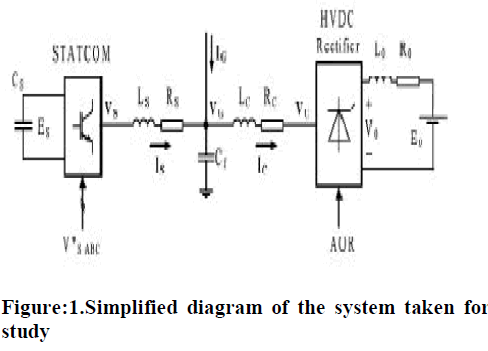 |
| The paper also deals with the engineering issues of STATCOM sizing by simulating on PSCAD and gives recommendations for control system enhancement. |
| The paper (4) presents an overview of the major issues concerning the expansion of the European transmission system for the connection and for the integration. The first issue concerned in the paper is the connection solutions for the offshore wind farms. The author discussed about this issue by taking a 100MW offshore wind farm, the connections taken were 150KV ac and VSC-HVDC. The economic assessment takes into account the investment, operation and maintenance costs which proved the reliability of VSC-HVDC over AC cables. |
| The second issue focused is the reinforcement of the onshore transmission system for accommodating the power produced by the wind farm under-taking the system security. In this, the prospects for developing the offshore wind farm taking into consideration the present European system. |
| The third issue discusses the options for facilitating transmission investments which shows that HVDC costs more than AC cables. |
| The paper discussed the overall costs involved in the maintenance, installation and operation of the various transmission systems. The paper tells that the VSCHVDC is more reliable and efficient. |
| Paper (5) performs the modeling of large offshore wind farm using Dig SILENT power factory simulation package. The wind technology used is active stall regulated wind turbine driving fixed speed synchronous generators. The two different types of interconnections are modeled and compared, VSC-HVDC and an AC cable interconnection. Wind turbine technology options used in large offshore wind farms built to date are-1) variable speed pitch regulated wind turbine driving doubly fed asynchronous generator; 2) fixed speed active stall regulated wind turbine is driving asynchronous generator. The study performed in the paper deals with the second option because of its simplicity, robustness and lower maintenance requirements that are vital for offshore applications. |
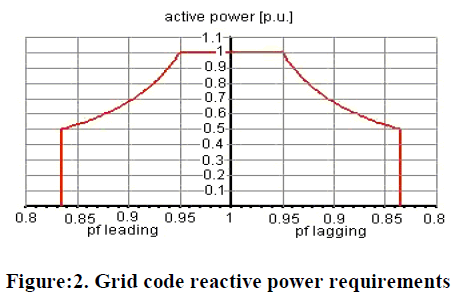 |
| The aim of the work performed is to investigate the interconnection of large offshore wind farm to the transmission system with a particular focus on compliance with the voltage and fault ride through requirements of the grid code. |
| The fault study compares the performance of the VSC based HVDC interconnection system, HVAC interconnection and conventional synchronous generator. The study reveals that all the system recovers from the 100ms fault duration but for 625ms fault duration VSC and synchronous generator recovers whereas the HVAC interconnection does not. |
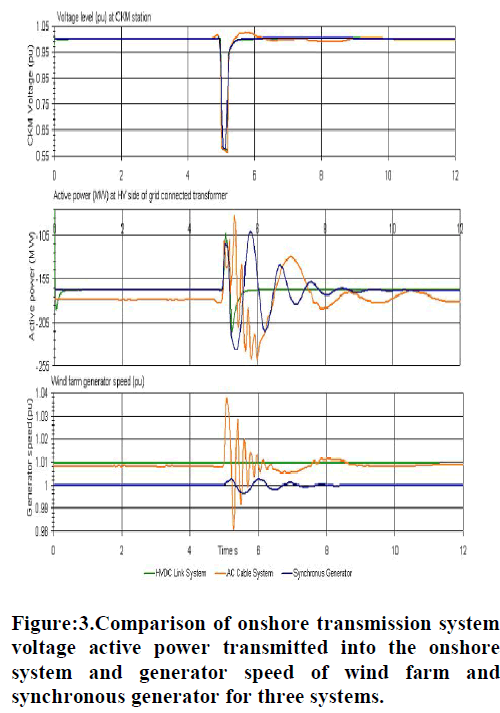 |
| The onshore transmission voltage is shown, measured CKM at 220kv station. The AC cable recovers the fault much slower than the other two systems. |
| The paper is still incomplete as the work is still under process. |
| Paper (6) presents a multi-terminal HVDC connection with an appropriate offshore circuit design facilitating the use of transmission converter for turbine speed control thus avoiding converter system with individual turbines. The simulation performed confirms the capability of the wind farms to operate each VSC converter at different frequency. This enables optimum speed regulation at each turbine group and there are no loss of synchronism in a single turbine group even at varying speeds. |
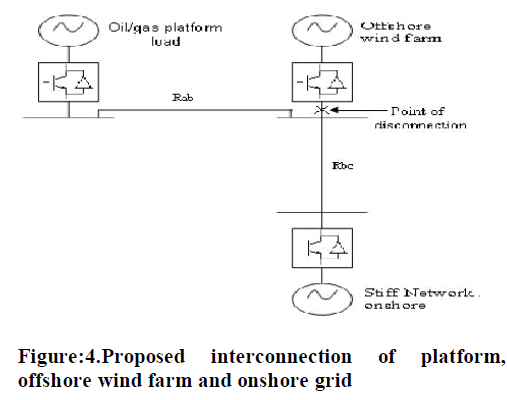 |
| The paper presents an idea that if VSC converters are employed the regulation of generator speed and voltage is possible, thus enabling the use of simple permanent magnet generator. |
| The various simulation results for the proposed model are- |
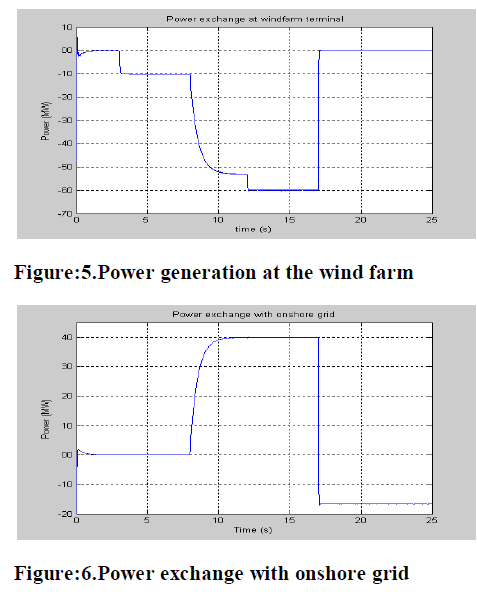 |
| Paper (7) aims to find out the best choice intern of generator technology for large offshore wind farm connected to the EHV network by means of VSC-HVDC transmission under variable frequency operation. In this types of generators a) Squirrel Cage Induction Generator (SCIG) b) Doubly-Fed induction Generator (DFIG) are compared for variable frequency operation. |
| Here, VSC-HVDC transmission system is considered as it allows variable frequency operation in order to increase the overall production of the wind farm. |
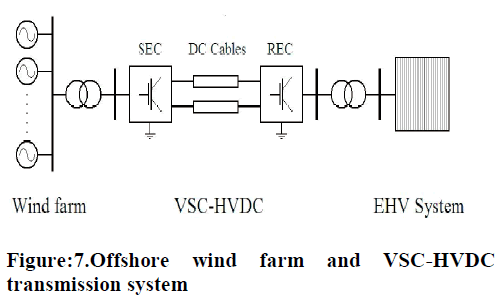 |
| The test results show that SCIG may ensure performance comparable to more expensive DFIG plant layout. DFIG is costlier than SCIG but provide better operating flexibility. |
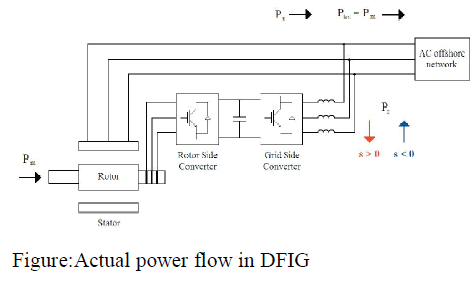 |
III. CONCLUSION |
| The paper shows the increasing interest of large offshore wind farms as they ensure larger availability of sites, better wind resource and smaller environmental impact. |
| The survey done on the papers confirmed that each system has its own viability and the most feasible interconnection comes from HVDC. The use of VSC based HVDC will be a perfect solution if its cost is decreased or else using LCC based HVDC is more reliable if STATCOM is installed as a common bus system. The AC cables have less reliability because of the capacitor charging with the increase in distance of the onshore grid to the offshore grid. The simulations are performed on PSCAD revealing the best results. |
| The work performed in the survey papers are in the European system; this work can also be dealt in the Indian system which is the upcoming work. |
References |
|